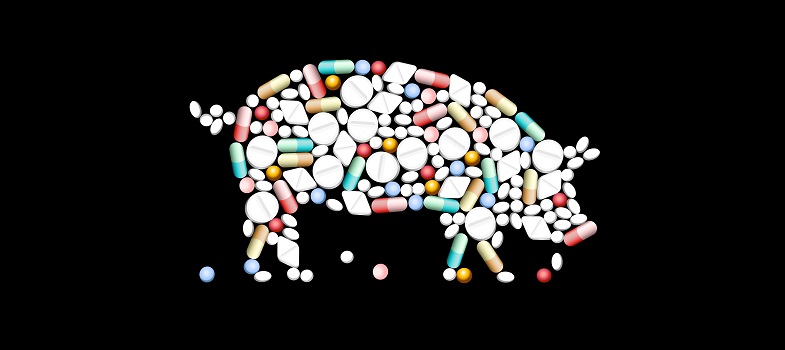Glossary
Special | A | B | C | D | E | F | G | H | I | J | K | L | M | N | O | P | Q | R | S | T | U | V | W | X | Y | Z | ALL
A |
|---|
antimicrobial consumption (AMC)The quantity of antimicrobial drugs imported, manufactured and/or sold for use in human or veterinary medicine in a country. It is typically expressed as the 'defined daily dose’. | |
antimicrobial residuesAntimicrobial drug molecules, or their metabolites, that remain in the meat of an animal after treatment, or are excreted into the environment by an animal or person, or enter the environment via water (e.g. via effluent and wastewater systems or antibiotic treatment of aquatic species) or pharmaceutical waste. | |
antimicrobial resistance (AMR) surveillanceThe collection, validation, analysis and reporting of relevant microbiological and epidemiological data on AMR in foodborne bacteria from humans, animals and food, and on relevant antimicrobial use (AMU) in humans and animals (WHO, 2017). | |
antimicrobial resistant genes (ARGs)Genes that confer antibiotic resistance to bacteria. | |
antimicrobial susceptibility testing (AST)A microbiological test to determine whether bacteria are susceptible or resistant to an antibiotic. | |
antimicrobial use (AMU)The quantity of antimicrobial drugs prescribed or administered to an individual person or animal, or group of animals (e.g. herd, flock), measured at the level of healthcare facility, farm, region or country. It is typically measured as kg of antibiotics. | |
B |
|---|
biasA systematic error due to the design, implementation or analysis of the surveillance system. Bias reduces as representativeness increases. | |
biomassThe weight or total quantity of living organisms of one animal or plant species (species biomass), or of all the species in a community (community biomass), commonly referred to as a unit area or volume of habitat. | |
C |
|---|
clusteringA lack of independence between samples; for example, because they are taken from the same farm. Infection in a country, zone or compartment usually clusters rather than being uniformly or randomly distributed through a population. Clustering may occur at a number of different levels, such as a cluster of infected animals within a herd or flock, a cluster of pens in a building, or a cluster of farms in a compartment. It should be taken into account in the design of surveillance activities and the statistical analysis of surveillance data, at least at what is judged to be the most significant level of clustering for the particular animal population and infection. | |
commensalBacteria species that are part of the normal flora (microbiome) of a human or animal, and do not normally cause disease. | |
D |
|---|
dose-based metricsA system to quantify the use of antimicrobials using the dose (usually a dose index, such as the defined daily doses) of active ingredient in the numerator. | |
E |
|---|
enhanced passive surveillanceAn observer-initiated provision of animal health-related data with active investigator involvement: for example, by actively encouraging producers to report certain types of disease, or actively following up suspect disease reports. | |
evaluationThe systematic and objective assessment of the relevance, adequacy, progress, efficiency, effectiveness and impact of a course of actions, in relation to objectives and taking into account the resources and facilities that have been deployed. | |
extended-spectrum beta-lactamase (ESBL)An enzyme that increases resistance to certain antibiotics. | |
H |
|---|
hazardA biological (such as resistant bacteria or antimicrobial resistance genes (ARGs)), chemical or physical agent in or condition of food, with the potential to cause an adverse health effect. | |
horizontal gene transferThe process of transferring genetic information between two unrelated cells. It is the primary mechanism of spreading AMR because it allows bacteria to spread antimicrobial resistance genes (ARGs) rapidly between different species. | |
I |
|---|
indicator bacteriaBacteria whose presence in different settings is monitored to give us an indication of the magnitude of the AMR problem. | |
M |
|---|
metaphylaxisAlso known as metaphylactic use, this is administering therapeutic doses of antimicrobials to groups of animals to prevent the spread of clinical disease once some animals in the group show symptoms. | |
microbiomeThe collection of all the microbial genes in the microbiota. | |
microbiotaThe community of micro-organisms living together in a particular habitat. | |
molecular methodsLaboratory techniques for investigating resistant bacteria based on the analysis of molecules such as DNA, RNA and protein. | |
monitoringThe intermittent performance and analysis of routine measurements and observations, aimed at detecting changes in the environment or health status of a population. | |
multidrug resistanceResistance to more than one antimicrobial. | |
P |
|---|
passive surveillanceAlso known as reactive surveillance, this is ‘the observer-initiated provision of animal health-related data (e.g. voluntary notification of suspect disease) or the use of existing data for surveillance. Decisions about whether information is provided, and what information is provided from which animals, is made by the data provider’ (Hoinville, 2013). | |
pathogenicCapable of causing disease. | |
point prevalence surveyA data collection tool, as a cross-sectional study, to obtain information on the prevalence of resistant bacteria, prescribing practices of antibiotics or other information relevant to treating and managing infectious diseases in hospitalised patients or animal production and the rest of the food chain. | |
policy purposeHow surveillance information is used by policy-makers to inform policy objectives. | |
prevalenceThe proportion of a population suffering from a particular disease at a particular time. For example, the proportion of Salmonella isolates that are resistant to a particular antimicrobial at the time of testing. | |
prophylaxisAlso known as prophylactic use, this is a series of measures designed to preserve health and prevent the spread of disease, protective or preventive treatment. For example, administering therapeutic doses of antimicrobials to groups of animals to prevent clinical disease. | |
R |
|---|
reservoirAny component of a system that can contain resistant bacteria or antimicrobial resistance genes (ARGs). | |
riskThe estimated probability and severity of adverse health effects in exposed populations consequential to hazards. | |
risk factorsFactors that influence the risk of causing adverse effects (such as contracting an AMR infection) in specific subpopulations. | |
S |
|---|
sampling frameA list of sampling units in the target population that samples can be collected from. | |
screeningSimple tests across an apparently healthy population in order to identify individuals who have risk factors or early stages of disease, but do not yet have clinical signs. | |
sentinel surveillanceA form of active surveillance that is ‘the repeated collection of information from the same selected sites or groups of animals (e.g. veterinary practices, laboratories, herds or animals) to identify changes in the health status of a specified population over time. These sentinels should act as a proxy for the larger population of interest; they may be selected on the basis of risk but can also be selected randomly or on the basis of convenience or compliance’ (Hoinville, 2013). | |
stakeholdersProfessionals, people or organisations involved in a system such as a food animal production system. | |
sub-therapeuticA dose of a drug that is insufficient for a clinical effect. Sub-therapeutic doses of antimicrobials kill susceptible bacteria, enabling the resistant bacteria to increase in the population. | |
surveillanceThe ongoing, systematic collection, analysis and interpretation of human and/or animal health-related data essential to planning, implementation and evaluation of public health practice. It includes dissemination of the information to those who need to know so that action can be taken. | |
surveillance component‘A single surveillance activity (defined by the source of data and the methods used for its collection) used to investigate the occurrence of one or more hazards in a specified population’ (Hoinville et al., 2013). | |
surveillance objectiveThe goal that, when met, will result in collecting and analysing data that achieves the purpose of the system. | |
surveillance purposeInformation to be obtained about occurrence of a health hazard (e.g. a resistant bacteria). | |
syndromic surveillanceHealth-related information (clinical signs or other data) that might precede (or may substitute for) formal diagnosis. This information may be used to indicate a sufficient probability of a change in the health of the population, either to deserve further investigation or to enable a timely assessment of the impact of health threats that may require action. | |
T |
|---|
target populationAlso known as a reference population, this refers to the population that the results will be extrapolated to (e.g. all commercial broiler farms in a country). | |
therapeutic useUse of antibiotics to treat animals showing signs of disease. | |
W |
|---|
weight-based metricsA system to quantify the use of antimicrobials using the quantity of active ingredient (mg or kg) in the numerator. | |
withdrawal periodAlso known as a withholding period, this is the minimum period required between the last administration of the antimicrobial and the slaughter or harvest. | |
Z |
|---|
zoonotic bacteriaBacteria that can be transmitted directly or indirectly from animals to people and cause infection. | |
For further information, take a look at our frequently asked questions which may give you the support you need.
If you have any concerns about anything on this site please get in contact with us here.



